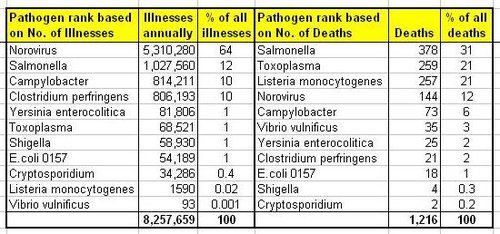| « Riots in UK could Forshadow Riots in US | Farewell Content: Class Wars and Ass Wars—Bringing It All Back Home! » |
Behind the Foodborne Illness Numbers: Politics vs Science
By Rady Ananda

With all the milk raids over the past few years, you wouldn’t think that dairy is the safest type of food in the U.S., or that factory foods cause 70% of all foodborne illnesses – but that’s just what a new study by the University of Florida reveals. [1]
Using data from the Centers for Disease Control (CDC) [2] and other peer-reviewed sources covering the years 1999 thru 2008, UF sought to determine which pathogens on which foods pose the highest risk.
UF produced a Top 10 chart revealing that “complex” factory foods (defined as non-meat factory foods with a host of additives) account for a whopping 70% of 3.9 million annual foodborne illnesses (resulting in 765 deaths).
Below is the ranking based just on number of illnesses and deaths per food group (leaving out other factors that UF used):

.
Dairy caused 434 illnesses out of 3.9 million. That’s about 1/100th of a percent of all foodborne illnesses. Quite an extremely rare event. By the way, “almost all” of the dairy contamination was “due to soft-ripened cheeses” – mostly queso fresco.
But UF determined that dairy is the fifth most dangerous food group sold in the U.S, by weighting various other factors, like “quality of life-year” and lethality. [3]
Still, 434 dairy-induced illnesses out of 3.9 million total foodborne illnesses and it ranks 5th most dangerous food group? Take a look at the above chart again. Which food group looks most dangerous to you?
Here’s UF’s Top 10 chart, where they segregated categories based on food-pathogen connection:
.
No doubt, there is merit to qualifying the data. A bout of diarrhea [4] that lasts a day is a hell of a lot different from a brain infection [5] lasting ten years that eventually kills you.
Though dairy caused only 434 illnesses out of 3.9 million, 70 of those people died. That’s 1 out of 6. Same goes for deli meats – only 651 illnesses out of 3.9 million. Yet, because 1 out of 6 people died from it, UF ranked deli meats as the third most dangerous food group.
That’s quite a stretch, requiring a strong imagination. UF’s risk system simply fails to consider the rarity of foodborne illnesses from a specific food group and therefore cannot be relied upon in developing food safety policies.
In UF's Top 10 chart, we get a real sense of a political agenda behind the ranking. Factory foods (that cause 70% of all foodborne illnesses and the highest percentage of deaths) is ranked at #6 and #7 in UF's Top 10 list.
UF also provided a Top 50 chart. Again, removing UF’s qualifiers and creating a chart just based on number of illnesses and deaths, here’s the ranking of the most common and most dangerous foodborne pathogens:
.
Norovirus is the top concern [6] of the National Advisory Committee on Microbiological Criteria for Foods (NACMCF), accounting for 64% of all foodborne illness. Yet, UF ranks it 7th on its Top 10 chart.
Politics, Not Science, Behind Government Attacks on Raw Milk
Susan Vaughn Grooters, who contributed to the UF report, was just appointed to the NACMCF by Agriculture Secretary Tom Vilsack. [7] She’ll serve a two-year term as a “consumer representative.”
Dr. Wafa Birbari of junk food giant, Sara Lee Corp. also sits on the NACMCF.
Grooters currently works with STOP Foodborne Illness (formerly Safe Tables Our Priority), an organization that condemns raw dairy and urges broad expansion of federal control over food. In a playful charade, she recently tweeted:
“Really??? Really? I would beg to differ Sec. Vilsack! ..unless of course you’re proposing a change to policies... ;-) http://usat.ly/kceLEY”
These opinions echo the sentiments of the food “safety” gang that believes Americans have no right to food choice, no right to health, and no right to private contract.
How Bad It Is(n’t)
As the Director of Research and Education, Grooters is responsible for the STOP Foodborne Illness page, “Fact vs. Myth.” [8] As if unable to distinguish the two, SFI repeats unsubstantiated, fear mongering propaganda. We’ll start with an easy one:
“There are no documented health benefits associated with ingestion of unpasteurized milk or milk products.”
Quite the opposite is true. In 2006, researchers reported the “competitive exclusion” effect of good bacteria found in raw milk, observing that:
“Lactococcus lactis subsp. lactis C-1-92 and Enterococcus durans 152 … are bactericidal to Listeria monocytogenes or inhibit the growth of L. monocytogenes both in vitro and in biofilms.” [9]
Listeria monocytogenes is responsible for 1,591 illnesses a year, according to the 2011 CDC report (at Table 2). [2] That’s for all foods, not just milk.
Based on CDC data and Dept of Health and Human Services (DHS) data covering 1999 thru 2010, retired pathologist Ted Beals determined, “there have been no cases attributed to drinking raw milk in the last twelve years.” [10]

Not only are Lactococcus deadly to pathogenic bacteria, but they are vital to making certain cheeses and other fermented products. And, they have to be added back in when starting with pasteurized milk.
Grooters also repeats the tired warning that:
“Pregnant women, young children, the elderly and those with weakened immune systems should avoid unpasteurized products.”
It’s a wonder the human species survived 200,000 years before the food police came along! We know for certain that humans have been drinking unpasteurized animal milk for at least ten thousand years. [12] Our population certainly hasn’t decreased since then.
The enzymes and “friendly” bacteria destroyed by pasteurization boost our immunity. We know this based on the scientifically accepted “competitive exclusion” principle – the more friendly bacteria you have, the fewer pathogenic ones that survive. Friendly bacteria compose part of our immune system, and competitive exclusion is what the entire probiotics food industry is based on.
Pasteurized Milk Contaminations
Grooters also stated at the Myths and Facts page:
“Raw or unpasteurized milk can transmit many serious infectious diseases to children.”
Then why doesn’t it? Statistics from the UF report to which she contributed show dairy to be the safest of all foods, amounting to 1/100th of a percent of all foodborne illnesses annually.
In fact, raw milk is much safer than all other food. According to Dr Beals, in 2010, DHS reported 90,771 confirmed foodborne illnesses for the period 1999 thru 2010. Based on DHS data, Beals reports you are 35,000 times more likely to get sick from any food other than raw milk. [10]
Using government data, Beals calculated that 42 people become ill from contaminated raw milk each year, a figure which includes “both ‘confirmed’ and ‘presumed’ cases.”
Yet, in a single case of contaminated pasteurized milk in Massachusetts, 49 people became ill in 1983. Later, 14 of them died. An inspection found the pasteurization process up to snuff, leading scientists to question relying on pasteurization to kill listeria. [14]
In another single case of contaminated pasteurized milk, over 16,000 people became ill in several Midwest states. Later, up to 5 of them died. That 1985 calamity was called the “worst outbreak of Salmonella food poisoning in U.S. history.” [13] It even beats last year’s half-billion egg recall with just over 1,900 confirmed salmonella cases.
This single case of contaminated factory milk was more dangerous than all the raw milk produced and sold in the past 100 years.
Yet, state and federal authorities pursue raw milk producers as if they’re selling heroin. Grooters is part of the team propagandizing Americans against natural milk, while ignoring the science.
Given her statements, and the UF report she helped draft, Grooters is not at all a surprising choice for Secretary Vilsack to have made. But it is rather disingenuous to characterize her as representing consumers, when, clearly, she represents corporate aims to shut down natural dairy.
If President Obama truly wanted to develop a “science-based” food safety policy driven by “risk-based” analysis, [15] raw dairies would be promoted rather than criminalized. Instead, what we see is support for factory-processed foods adulterated with genetically modified organisms, drugs, chemicals, nanomaterials, rat droppings, and wood [16] – all permitted by the FDA.
Rady Ananda specializes in Natural Resources and administers the sites, Food Freedom and COTO Report. To obtain a full copy of this report, including Notes and Sources Used, click here.
An earlier version of this article appeared at Global Research: http://www.globalresearch.ca/index.php?context=va&aid=26017
.
No feedback yet





